Wed Aug 08, 2007 3:38 pm
Might as well add in my story. A coworker's granddad worked for the Illinois Central railroad. He said that at the end of the war, the military dug long trenches (Alabama) and laid track down in them. His granddad said he back whole trains full of stuff into those trenches, uncoupled the loco and drove off. Mostly office stuff and medical supplies, no aviation stuff that he was aware of.
Also, I read in an old Proceedings magazine, a man gave an account of disposing of Martin B-10s in Hawaii. They were barged out from base (I guess it was Pearl) and pushed over the side.
Also, I read in an old Proceedings magazine, a man gave an account of disposing of Martin B-10s in Hawaii. They were barged out from base (I guess it was Pearl) and pushed over the side.
Wed Aug 08, 2007 4:27 pm
If someone started snooping around some of the former replacement depot bases in the UK, one might find quite a bit of stuff buried.
The father of a high school friend had a few shots of B-17's being partially fuelled, run up (pointing out to the North Sea), having the chocks pulled & flying off into the ocean. He also remembered tons of material being buried by a bulldozer at that same base.
The father of a high school friend had a few shots of B-17's being partially fuelled, run up (pointing out to the North Sea), having the chocks pulled & flying off into the ocean. He also remembered tons of material being buried by a bulldozer at that same base.
Wed Aug 08, 2007 5:02 pm
Rumored in Florida.
Cant remember the Name of the base, think Masters Field. A blimp base in miami. Durring ww2, a hurricane came through and all 3 hangars burned down in a fire filled with both NAVY and Civilian airplanes. The wreckage of the airplanes NON-civilian, were burried in a big hole which is now the elephant cage at the Metro Zoo.
Farther up the coast at N.Perry Airport ( a satalite field for NAS FLL). I worked there for 6 yrs. When our company built our new hangars in the south east corner, we were finding many parts and .30 cal LIVE ammo dated 41.
NAS FLL. Dad works there at airport operations. They were digging a access road and the dozer operator dug up 38 practice bombs in one pass. Driver bolted and was not seen for a few hrs!!! Found in the pile that dad brought home.........Escape hatch frame for a TBF turret. license plate for a car that was stamped USN NAS FLL
Recently dad was called where they were doing some digging and unearthed something big!!!
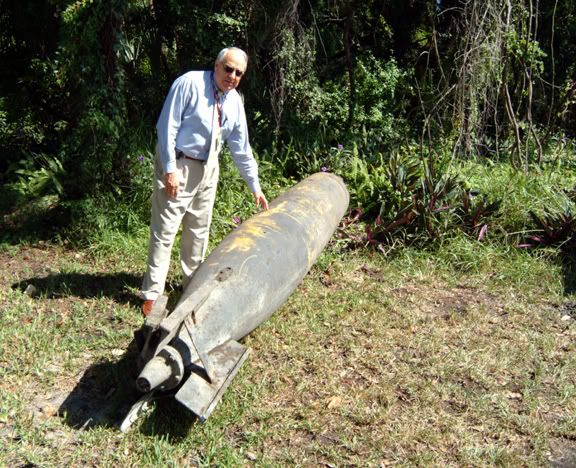
Last i knew, he was going to have it cleaned up and donated to a TBM on display in FLA.
Cant remember the Name of the base, think Masters Field. A blimp base in miami. Durring ww2, a hurricane came through and all 3 hangars burned down in a fire filled with both NAVY and Civilian airplanes. The wreckage of the airplanes NON-civilian, were burried in a big hole which is now the elephant cage at the Metro Zoo.
Farther up the coast at N.Perry Airport ( a satalite field for NAS FLL). I worked there for 6 yrs. When our company built our new hangars in the south east corner, we were finding many parts and .30 cal LIVE ammo dated 41.
NAS FLL. Dad works there at airport operations. They were digging a access road and the dozer operator dug up 38 practice bombs in one pass. Driver bolted and was not seen for a few hrs!!! Found in the pile that dad brought home.........Escape hatch frame for a TBF turret. license plate for a car that was stamped USN NAS FLL
Recently dad was called where they were doing some digging and unearthed something big!!!

Last i knew, he was going to have it cleaned up and donated to a TBM on display in FLA.
Wed Aug 08, 2007 8:40 pm
A more sobering thought along this thread.. after seeing the torpedo dug up in Fla., what about LIVE ordinance that was buried?? Could be scary. Some of that stuff stays hot for a long time. WWI stuff is still dangerous in western Europe and Civil War ordinance in the US is still considered lethal. Not to mention the Long Lance that was dredged up in Pearl a few years ago.
Canso42, wondering in Texas.
Canso42, wondering in Texas.
Blimp Base
Wed Aug 08, 2007 11:20 pm
Rick, I have been to the blimp base at Hitchcock. I went to school in Houston with the Mecom kids; same school as W Bush. Lannie was in my grade, nice girl, pretty good friend. Her older sister Betsy was about my sister's age, the brother John a little older. John once broke a finger in a high school football game, taped it up and continued to play. I think he may have later been an owner of the Saints. About the 9th grade we had a school party at the blimp base. The wood rafters inside were pretty old and roped off. Someone dared me to climb across on the rafters near the roof inside the hangar. I did it mainly because I wanted to impress a girlfriend. Coincidence, her Father worked for Bob Waltrip who founded Lone Star. Part way across the rickety 2x4s, I realized if I fell it would be onto the concrete floor and probably fatal, but I was young, brave, and dumb. I did win the $5 dollar bet, and hopefully try not to do nutty things since. I have not been back, wish the hangar was still there.
Thu Aug 09, 2007 8:43 am
Neat story, Bill.
Gee, when I met you at Galveston you didn't look that old. I never saw the big hangar when it was still standing, it was gone after Carla in '63. The corner supports are still a big landmark, especially from the bayside.
I never saw the big hangar when it was still standing, it was gone after Carla in '63. The corner supports are still a big landmark, especially from the bayside.
Gee, when I met you at Galveston you didn't look that old.
Thu Aug 09, 2007 11:49 am
Canso42 wrote:A more sobering thought along this thread.. after seeing the torpedo dug up in Fla., what about LIVE ordinance that was buried??
You won't want to go digging on that huge expanse up in Canada that the UK army use for tank training, they STILL bury live shells as firing off all of their "allowance" wears the barrels out & they have to change them.... It's so bad thats it's not unusual for one tank crew to find some other crews left over shells when trying to bury their own....
Thu Aug 09, 2007 1:45 pm
At Bradley International Airport in CT, they were building an access road in the late 1980's and dug up a dump with live ordinance. Jeep parts bombs etc. were all pulled out before the building could continue.
Jerry
Jerry
Sun Aug 12, 2007 6:18 pm
About a year ago a Cessna Caravan flew into the FBO I work at. I had, had this aircraft in before and knew it was usually configured for some type of aerial survey / mapping work. When I asked what they were doing this time, they said thy had a contract to fly over past and present military installations. I forgot what kind of electronics they said they were carrying, infrared cameras, ground penetrating radar, or some combination of such equipment. The purpose of the contract was to find hazardous materials (toxic waste and munitions) buried by the military when this was an still an accepted method of disposal. I thought that it was pretty cool they could do that, but didn't think much into it at the time. After they left I realized that if they were looking of buried materials on military installations, the equipment was probably also showing the location of any buried aircraft. Unfortunately I never thought to ask who was compiling the information or whether it is available for public viewing. I also can't remember who was operating the aircraft or its N-number. I know they were out of Oregon and the aircraft was overall blue with yellow and red / orange stripes.
I also have some pictures of dumped stuff I've found. I'll try to post them soon.
Curtis Block
I also have some pictures of dumped stuff I've found. I'll try to post them soon.
Curtis Block
Sun Aug 12, 2007 7:40 pm
Not WWII but WWI:
During WWI American University in NW Washington, DC was the home of the US Army Chemical Warfare Corps. Lots of testing took place on campus and in the valley (Spring Valley, aka Death Valley) behind the school. At the end of the war stuff was just taken out an buried.
Fast forward 70 or so years. The student body at AU has general knowledge of the history of the school - to the point that when students develop slight rashes after playing intramural football on the back field they joke about it being from all the mustard gas residue in the soil. Hahaha.
Then, when foundations are being dug for a new housing development behind the school, the weapons disposal pits are found. At about the same time a student walking to school across the soccer field literally trips over a partly-unearthed shell. Not the brightest tool in the shed, the kid pulls it out and takes it into the campus security office. Campus security has an aneurism, 1/2 the campus gets evacuated, Army EOD gets called in and while little official mention is made of the incident word gets around that it was a live 75mm mustard shell.
The intramural field (which the brand-new campus daycare center - built inside an old fraternity house - backs onto) is found to be heavily contaminated with arsenic (explains the strange rashes, I guess), and is fenced off for 10 years while the Army tries to clean it out.
The last I heard, a few years back, is that the official resident of the South Korean Ambassador - which is right behind the school - was being dug up due to chemical weapons-related contamination.
Then there's the real reason why Ft. Monroe VA survived multiple BRAC rounds ...
During WWI American University in NW Washington, DC was the home of the US Army Chemical Warfare Corps. Lots of testing took place on campus and in the valley (Spring Valley, aka Death Valley) behind the school. At the end of the war stuff was just taken out an buried.
Fast forward 70 or so years. The student body at AU has general knowledge of the history of the school - to the point that when students develop slight rashes after playing intramural football on the back field they joke about it being from all the mustard gas residue in the soil. Hahaha.
Then, when foundations are being dug for a new housing development behind the school, the weapons disposal pits are found. At about the same time a student walking to school across the soccer field literally trips over a partly-unearthed shell. Not the brightest tool in the shed, the kid pulls it out and takes it into the campus security office. Campus security has an aneurism, 1/2 the campus gets evacuated, Army EOD gets called in and while little official mention is made of the incident word gets around that it was a live 75mm mustard shell.
The intramural field (which the brand-new campus daycare center - built inside an old fraternity house - backs onto) is found to be heavily contaminated with arsenic (explains the strange rashes, I guess), and is fenced off for 10 years while the Army tries to clean it out.
The last I heard, a few years back, is that the official resident of the South Korean Ambassador - which is right behind the school - was being dug up due to chemical weapons-related contamination.
Then there's the real reason why Ft. Monroe VA survived multiple BRAC rounds ...
Mon Aug 13, 2007 9:26 am
From the AP today!
WWII mortar shell goes off in So. Oregon man's field
09:06 PM PDT on Sunday, August 12, 2007
Associated Press
MEDFORD, Ore. -- Mortar shells dating from World War II may still pose a potential hazard in Southern Oregon after a landowner found one by accident in the Medford area and it went off after more than 60 years.
Dean Harris was on a bulldozer clearing brush from his property near an old artillery range in Sams Valley when he spotted a shell in an area he had just finished tilling.
Harris picked it up and left it on a stump, where the projectile later burst into flames.
Bombs and shells loaded with phosphorous were used extensively in World Wars I and II. Phosphorous is so chemically reactive that it bursts into flame on exposure to the atmosphere and is not easily extinguished.
Harris says he now agrees with bomb experts -- leave it to them next time.
WWII mortar shell goes off in So. Oregon man's field
09:06 PM PDT on Sunday, August 12, 2007
Associated Press
MEDFORD, Ore. -- Mortar shells dating from World War II may still pose a potential hazard in Southern Oregon after a landowner found one by accident in the Medford area and it went off after more than 60 years.
Dean Harris was on a bulldozer clearing brush from his property near an old artillery range in Sams Valley when he spotted a shell in an area he had just finished tilling.
Harris picked it up and left it on a stump, where the projectile later burst into flames.
Bombs and shells loaded with phosphorous were used extensively in World Wars I and II. Phosphorous is so chemically reactive that it bursts into flame on exposure to the atmosphere and is not easily extinguished.
Harris says he now agrees with bomb experts -- leave it to them next time.
Fri Aug 17, 2007 11:20 pm
How this for COOL things being dumped by the military. These photos were taken a couple of years ago by Bill Jeffery on a dive we did with the Chuuk Historic Preservation Office.
The purpose of the dive was to positively identify an aircraft thought to be a Nakajima B6N “Jill,” and document the site I however had received information that the aircraft could be the much rarer Nakajima C6N “Myrt.” The site lies a short distance off shore from the old Japanese seaplane base on Moen (now Weno) in Truk Lagoon.
Close inspection of the aircraft revealed that it is in fact a C6N, a very advanced high speed, high altitude, reconnaissance aircraft, built late in the war. It is also apparent that the aircraft did not crash in that spot. Even looking at the pictures one can see that the aircraft lacks an engine, controls and instruments, portions of the wing and other components necessary for flight. I would venture to guess that the aircraft was damaged on or near the airbase and subsequently, cannibalized for parts. This aircraft as well as other artifacts (I have included pictures of the more interesting ones including the Zero and a torpedo) at the site were then most likely dumped by the US military after the war in an effort to clean up the island.
Even though the Nakajima C6N was on the list of aircraft wanted for evaluation after the war this particular aircraft was probably too far gone to be saved. Others however were more fortunate and one that that was not scrapped still exists as part of the Smithsonian collection. The only other example known to have survived, crashed in a taro patch on Weno, and remained there until shortly before I arrived in Micronesia (pictures can be found on Pacific Wrecks Database). Then it disappeared. Rumors stated it was crated and last seen on the docks. I have a hunch where it went but no proof.
Enjoy
Curtis Block
P.S.
The stick is 3 meters.
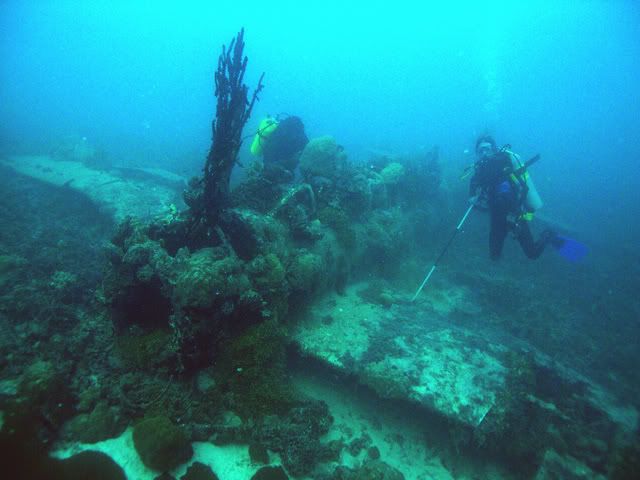
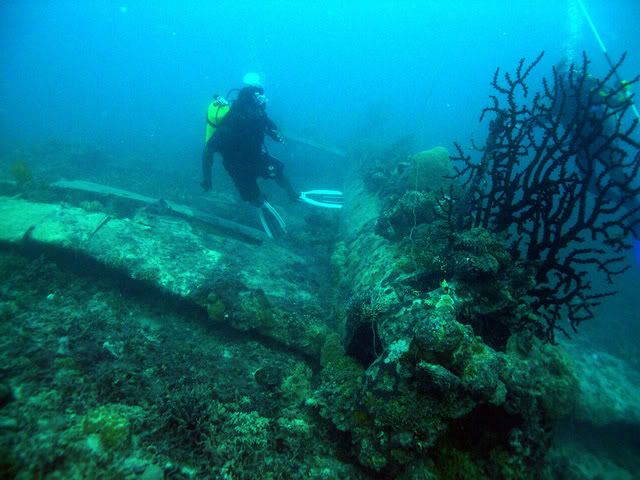
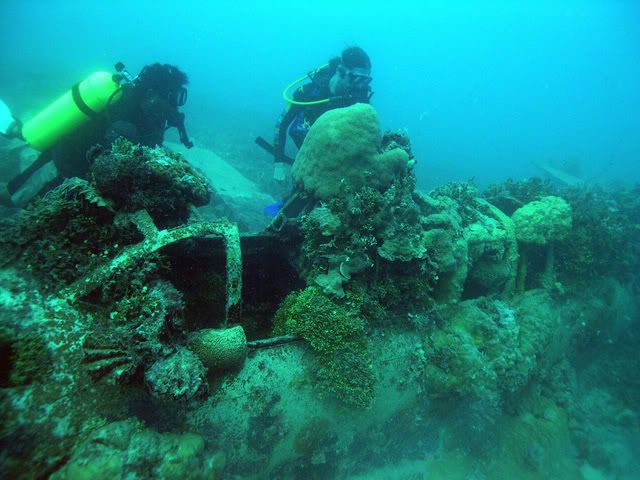
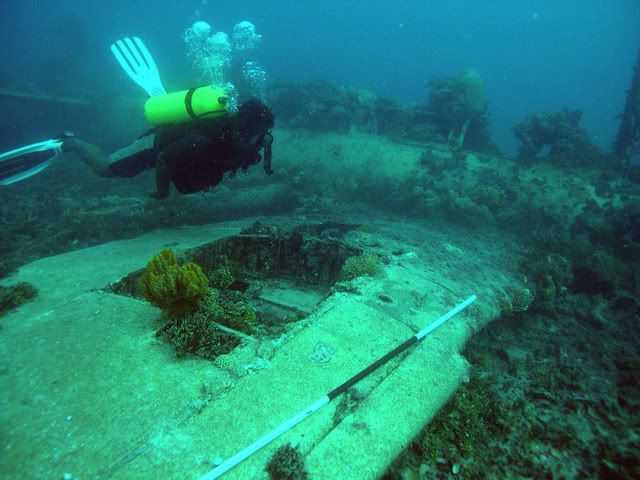
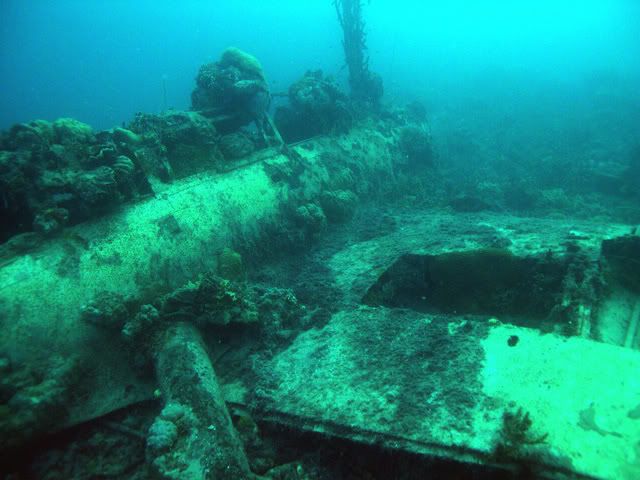
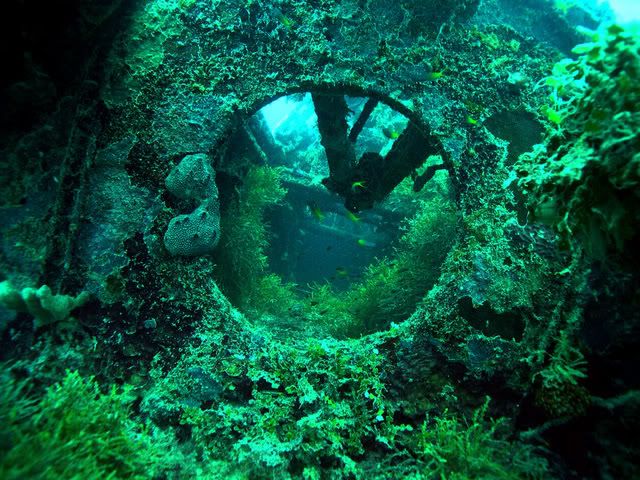
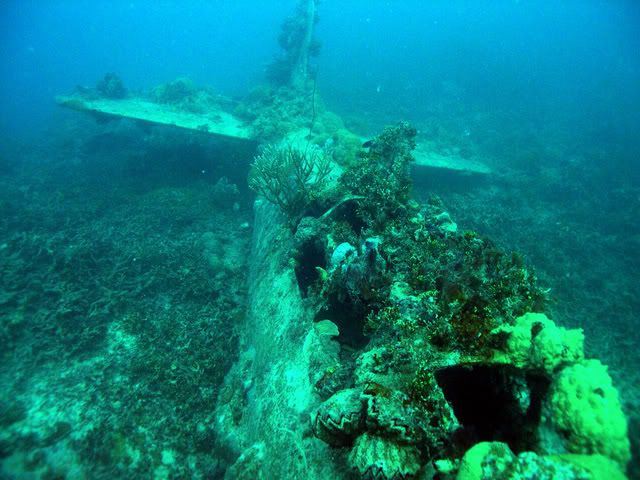
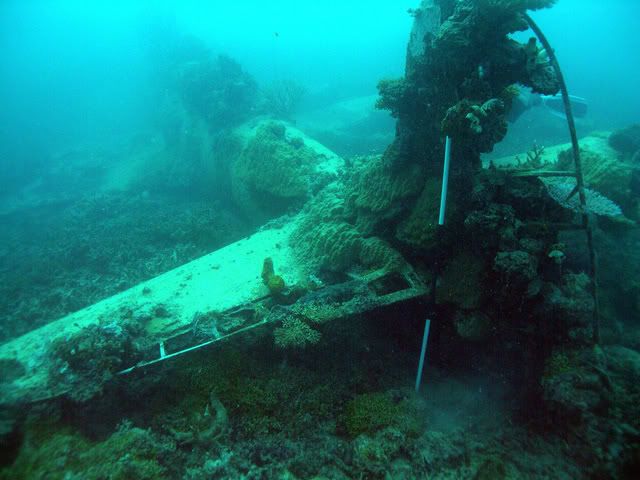
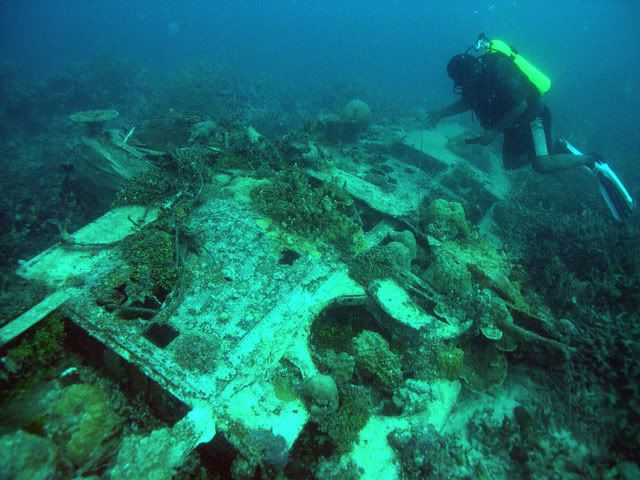
Mitsubishi Zero
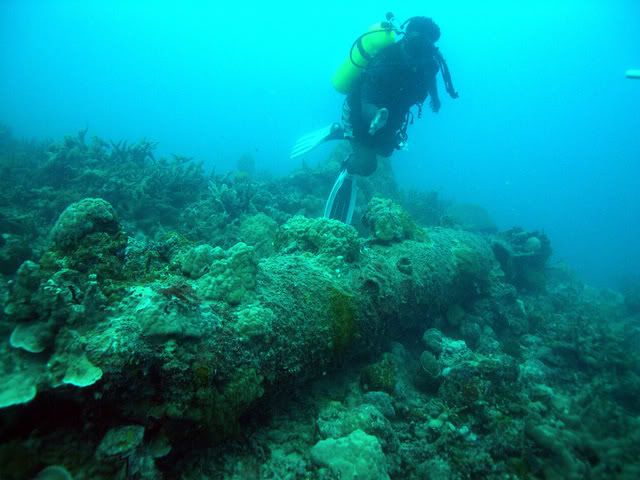
Torpedo (thank you Aramich, for the demonstration)
The purpose of the dive was to positively identify an aircraft thought to be a Nakajima B6N “Jill,” and document the site I however had received information that the aircraft could be the much rarer Nakajima C6N “Myrt.” The site lies a short distance off shore from the old Japanese seaplane base on Moen (now Weno) in Truk Lagoon.
Close inspection of the aircraft revealed that it is in fact a C6N, a very advanced high speed, high altitude, reconnaissance aircraft, built late in the war. It is also apparent that the aircraft did not crash in that spot. Even looking at the pictures one can see that the aircraft lacks an engine, controls and instruments, portions of the wing and other components necessary for flight. I would venture to guess that the aircraft was damaged on or near the airbase and subsequently, cannibalized for parts. This aircraft as well as other artifacts (I have included pictures of the more interesting ones including the Zero and a torpedo) at the site were then most likely dumped by the US military after the war in an effort to clean up the island.
Even though the Nakajima C6N was on the list of aircraft wanted for evaluation after the war this particular aircraft was probably too far gone to be saved. Others however were more fortunate and one that that was not scrapped still exists as part of the Smithsonian collection. The only other example known to have survived, crashed in a taro patch on Weno, and remained there until shortly before I arrived in Micronesia (pictures can be found on Pacific Wrecks Database). Then it disappeared. Rumors stated it was crated and last seen on the docks. I have a hunch where it went but no proof.
Enjoy
Curtis Block
P.S.
The stick is 3 meters.









Mitsubishi Zero

Torpedo (thank you Aramich, for the demonstration)
Sat Aug 18, 2007 1:41 am
Garth wrote:Not WWII but WWI:
Then there's the real reason why Ft. Monroe VA survived multiple BRAC rounds ...
I used to love going to the big lodge there. It has great big exposed log beams and flags hanging all over the place and a cozy little lounge downstairs. And when you were good and drunk you could stagger out the back porch and look at the mountain...And the guys taht worked int the mountain would tell the most interesting stories about went on down in there...